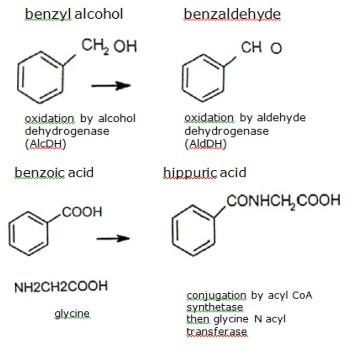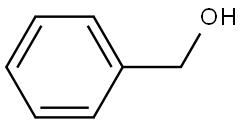Chemical Properties
colourless liquid
Definition
ChEBI: An aromatic alcohol that consists of benzene bearing a single hydroxymethyl substituent.
General Description
A clear colorless liquid with a pleasant odor. Slightly denser than water. Flash point 194°F. Boiling point 401°F. Contact may irritate skin, eyes, and mucous membranes. May be slightly toxic by ingestion. Used to make other chemicals.
Reactivity Profile
Attacks plastics. [Handling Chemicals Safely 1980. p. 236]. Acetyl bromide reacts violently with alcohols or water [Merck 11th ed. 1989]. Mixtures of alcohols with concentrated sulfuric acid and strong hydrogen peroxide can cause explosions. Example: an explosion will occur if dimethylbenzylcarbinol is added to 90% hydrogen peroxide then acidified with concentrated sulfuric acid. Mixtures of ethyl alcohol with concentrated hydrogen peroxide form powerful explosives. Mixtures of hydrogen peroxide and 1-phenyl-2-methyl propyl alcohol tend to explode if acidified with 70% sulfuric acid [Chem. Eng. News 45(43):73 1967; J, Org. Chem. 28:1893 1963]. Alkyl hypochlorites are violently explosive. They are readily obtained by reacting hypochlorous acid and alcohols either in aqueous solution or mixed aqueous-carbon tetrachloride solutions. Chlorine plus alcohols would similarly yield alkyl hypochlorites. They decompose in the cold and explode on exposure to sunlight or heat. Tertiary hypochlorites are less unstable than secondary or primary hypochlorites [NFPA 491 M 1991]. Base-catalysed reactions of isocyanates with alcohols should be carried out in inert solvents. Such reactions in the absence of solvents often occur with explosive violence [Wischmeyer 1969].
Air & Water Reactions
Slightly soluble in water.
Health Hazard
Inhalation of vapor may cause irritation of upper respiratory tract. Prolonged or excessive inhalation may result in headache, nausea, vomiting, and diarrhea. In severe cases, respiratory stimulation followed by respiratory and muscular paralysis, convulsions, narcosis and death may result. Ingestion may produce severe irritation of the gastrointestinal tract, followed by nausea, vomiting, cramps and diarrhea; tissue ulceration may result. Contact with eyes causes local irritation. Material can be absorbed through skin with anesthetic or irritant effect.
Fire Hazard
This chemical is combustible.
Description
Benzyl alcohol is a component catalyst for epoxy
resins. It is also contained in the color developer C-22.
Physical properties
Colorless, hygroscopic, air sensitive liquid with a faint, pleasant, aromatic odor. Odor threshold
concentration in water is 10 ppm (Buttery et al., 1988).
Occurrence
The free alcohol is often present in several essential oils and extracts of jasmine, tobacco, tea, neroli, copaiba,
Acacia farnesiana Willd., Acacia cavenia Hook. and Arn., Robinia pseudacacia, ylang-ylang, Pandanus odoratissimus, Michelia
champaca, Prunus laurocerasus, tuberose, orris, castoreum, violet leaves, clove buds and others. Also found in fresh apple, apricot,
mandarin peel oil, high bush blueberry, raspberry, strawberry fruit, American cranberry and cooked asparagus.
History
LIEBIG and WO¨HLER first prepared benzyl alcohol from bitter almond oil (benzaldehyde) in 1832. The structure of benzyl alcohol was determined in 1853 by CANNIZZARO. CANNIZZARO used the reaction named after him, in which benzaldehyde is disproportionated into benzoic acid and benzyl alcohol through the action of an alkali.
Preparation
By the action of alkalis on benzyl chloride
Production Methods
Benzyl alcohol is prepared commercially by the distillation of benzyl
chloride with potassium or sodium carbonate. It may also be
prepared by the Cannizzaro reaction of benzaldehyde and
potassium hydroxide.
World Health Organization (WHO)
Benzyl alcohol has been used as an antimicrobial agent in
pharmaceutical preparations for many years. Parenteral administration of
preparations containing 0.9% benzyl alcohol resulted in the death of 16 neonates in
the USA in the early 1980s. Many countries subsequently warned against using
such preparations in neonates. This decision is not applicable to the use of benzyl
alcohol as a preservative in other circumstances or to its use in topical
preparations and no country has placed a total ban on the compound.
Aroma threshold values
Detection: 1.2 to 1000 ppb; also 10 to 1000 ppm.
Taste threshold values
Taste characteristics at 50 ppm: chemical, fruity with balsamic nuances.
Flammability and Explosibility
Nonflammable
Chemical Reactivity
Reactivity with Water No reaction; Reactivity with Common Materials: Will attack some plastics; Stability During Transport: Stable; Neutralizing Agents for Acids and Caustics: Not pertinent; Polymerization: Not pertinent; Inhibitor of Polymerization: Not pertinent.
Pharmaceutical Applications
Benzyl alcohol is an antimicrobial preservative used in cosmetics,
foods, and a wide range of pharmaceutical formulations,
including oral and parenteral preparations, at concentrations up
to 2.0% v/v. The typical concentration used is 1% v/v, and it has
been reported to be used in protein, peptide and small molecule
products, although its frequency of use has fallen from 48 products
in 1996, 30 products in 2001, to 15 products in 2006. In
cosmetics, concentrations up to 3.0% v/v may be used as a
preservative. Concentrations of 5% v/v or more are employed as a
solubilizer, while a 10% v/v solution is used as a disinfectant.
Benzyl alcohol 10% v/v solutions also have some local anesthetic
properties, which are exploited in some parenterals, cough
products, ophthalmic solutions, ointments, and dermatological
aerosol sprays.
Although widely used as an antimicrobial preservative, benzyl
alcohol has been associated with some fatal adverse reactions when
administered to neonates. It is now recommended that parenteral
products preserved with benzyl alcohol, or other antimicrobial
preservatives, should not be used in newborn infants if at all
possible.
Safety
Benzyl alcohol is used in a wide variety of pharmaceutical
formulations. It is metabolized to benzoic acid, which is further
metabolized in the liver by conjugation with glycine to form
hippuric acid, which is excreted in the urine.
Ingestion or inhalation of benzyl alcohol may cause headache,
vertigo, nausea, vomiting, and diarrhea. Overexposure may result
in CNS depression and respiratory failure. However, the concentrations
of benzyl alcohol normally employed as a preservative are not
associated with such adverse effects.
Reports of adverse reactions to benzyl alcohol used as an
excipient include toxicity following intravenous administration; neurotoxicity in patients administered benzyl alcohol
in intrathecal preparations; hypersensitivity, although
relatively rare; and a fatal toxic syndrome in premature
infants.
The fatal toxic syndrome in low-birth-weight neonates, which
includes symptoms of metabolic acidosis and respiratory depression,
was attributed to the use of benzyl alcohol as a preservative in
solutions used to flush umbilical catheters. As a result of this, the
FDA has recommended that benzyl alcohol should not be used in
such flushing solutions and has advised against the use of medicines
containing preservatives in the newborn.
The WHO has set the estimated acceptable daily intake of the
benzyl/benzoic moiety at up to 5 mg/kg body-weight daily.
LD50 (mouse, IV): 0.32 g/kg
LD50 (mouse, oral): 1.36 g/kg
LD50 (rat, IP): 0.4 g/kg
LD50 (rat, IV): 0.05 g/kg
LD50 (rat, oral): 1.23 g/kg
Synthesis
By saponification of the ester present in Tolu and Pery balsams; synthetically, it is obtained from benzyl chloride by the
action of sodium or potassium carbonate.
Carcinogenicity
In an NTP study, F344 rats were
dosed by oral gavage with 0, 200, and 400 mg/kg, 5 days/
week for 2 years. Benzyl alcohol had no effect on the survival
of male rats; female rats had reduced survival, and many of
the early deaths were considered related to the gavage
procedure. There were no treatment-related effects on nonneoplastic
or neoplastic lesions in either sex treated with
benzyl alcohol. It was concluded that under the conditions of
the study, there was no evidence of carcinogenic activity
. In the same NTP study, B6C3F1 mice were dosed by
oral gavage with 0, 100, and 200 mg/kg, 5 days/week for
2 years. No effects on survival or body weight gain were
observed. There were no treatment-related effects on nonneoplastic
or neoplastic lesions in either sex. It was concluded
that under the conditions of the study, there was no
evidence of carcinogenic activity.
Source
Benzyl alcohol naturally occurs in tea (900 ppm), daffodils (165–330 ppm), hyacinths
(64–920 ppm), jasmine (120–228 ppm) rosemary (7–32 ppm), hyssop (0.1–30 ppm), tangerines
(1–2 ppm), blueberries (0.01–0.08 ppm in fruit juice), ylang-ylang, colocynth, licorice, roselle,
tomatoes, spearmint, sweet basil, apricots, tuberose (Duke, 1992), and small-flowered oregano
shoots (2 ppm) (Baser et al., 1991). Also identified among 139 volatile compounds identified in
cantaloupe (Cucumis melo var. reticulates cv. Sol Real) using an automated rapid headspace solid
phase microextraction method (Beaulieu and Grimm, 2001).
Environmental Fate
Biological. Heukelekian and Rand (1955) reported a 5-d BOD value of 1.55 g/g which is 61.5%
of the ThOD value of 2.52 g/g.
Chemical/Physical. Slowly oxidizes in air to benzaldehyde (Huntress and Mulliken, 1941).
Benzyl alcohol will not hydrolyze because it has no hydrolyzable functional group (Kollig, 1993).
Metabolism
Esters of benzyl alcohol are rapidly hydrolysed in vivo to benzyl alcohol, which is then oxidized . The animal organism readily oxidizes benzyl alcohol to benzoic acid, which after conjugation with glycine is rapidly eliminated as hippuric acid in the urine.

Benzyl alcohol is oxidised by alcohol dehydrogenase (AlcDH), a cytoplasmic enzyme present mainly in the liver, but also in the intestine and kidney. This reaction is saturable. The benzaldehyde formed is oxidised by aldehyde dehydrogenases (AldDH), cytoplasmic and mitochondrial enzymes mainly present in the liver, but also in the intestine and numerous organs.
storage
Benzyl alcohol oxidizes slowly in air to benzaldehyde and benzoic
acid; it does not react with water. Aqueous solutions may be
sterilized by filtration or autoclaving; some solutions may generate
benzaldehyde during autoclaving.
Benzyl alcohol may be stored in metal or glass containers. Plastic
containers should not be used; exceptions to this include
polypropylene containers or vessels coated with inert fluorinated
polymers such as Teflon.
Benzyl alcohol should be stored in an airtight container,
protected from light, in a cool, dry place.
Purification Methods
It is usually purified by careful fractional distillation under reduced pressure in the absence of air. Benzaldehyde, if present, can be detected by UV absorption at 283nm. It has also been purified by shaking with aqueous KOH and extracting with peroxide-free diethyl ether. After washing with water, the extract is treated with saturated NaHS solution, filtered, washed, dried with CaO and distilled under reduced pressure [Mathews J Am Chem Soc 48 562 1926]. Peroxy compounds can be removed by shaking with a solution of Fe2+ followed by washing the alcohol layer with distilled water and fractionally distilling it. [Beilstein 6 IV 2222.]
Toxicity evaluation
Due to an abundance of useful applications across society,
from industrial production to consumer products, benzyl
alcohol is present in the environment and is steadily released
through commercial and household waste streams. Benzyl
alcohol was an early object of chemists striving for greener
synthetic approaches involving mixed catalysts for oxidation. It
is released into the atmosphere entirely as a vapor due to its
high vapor pressure, where it is lost by degradation involving
reaction with hydroxyl radicals at a half-life of about 2 days.
Benzyl alcohol is expected to have quite high mobility based
upon its soil to water partition coefficient, and a projected soil
half-life of about 13 days.
Incompatibilities
Benzyl alcohol is incompatible with oxidizing agents and strong
acids. It can also accelerate the autoxidation of fats.
Although antimicrobial activity is reduced in the presence of
nonionic surfactants, such as polysorbate 80, the reduction is less
than is the case with hydroxybenzoate esters or quaternary
ammonium compounds.
Benzyl alcohol is incompatible with methylcellulose and is only
slowly sorbed by closures composed of natural rubber, neoprene,
and butyl rubber closures, the resistance of which can be enhanced
by coating with fluorinated polymers. However, a 2% v/v
aqueous solution in a polyethylene container, stored at 208℃, may
lose up to 15% of its benzyl alcohol content in 13 weeks. Losses
to polyvinyl chloride and polypropylene containers under similar
conditions are usually negligible. Benzyl alcohol can damage
polystyrene syringes by extracting some soluble components
Regulatory Status
Included in the FDA Inactive Ingredients Database (dental
injections, oral capsules, solutions and tablets, topical, and vaginal
preparations). Included in parenteral and nonparenteral medicines
licensed in the UK. Included in the Canadian List of Acceptable
Non-medicinal Ingredients.

